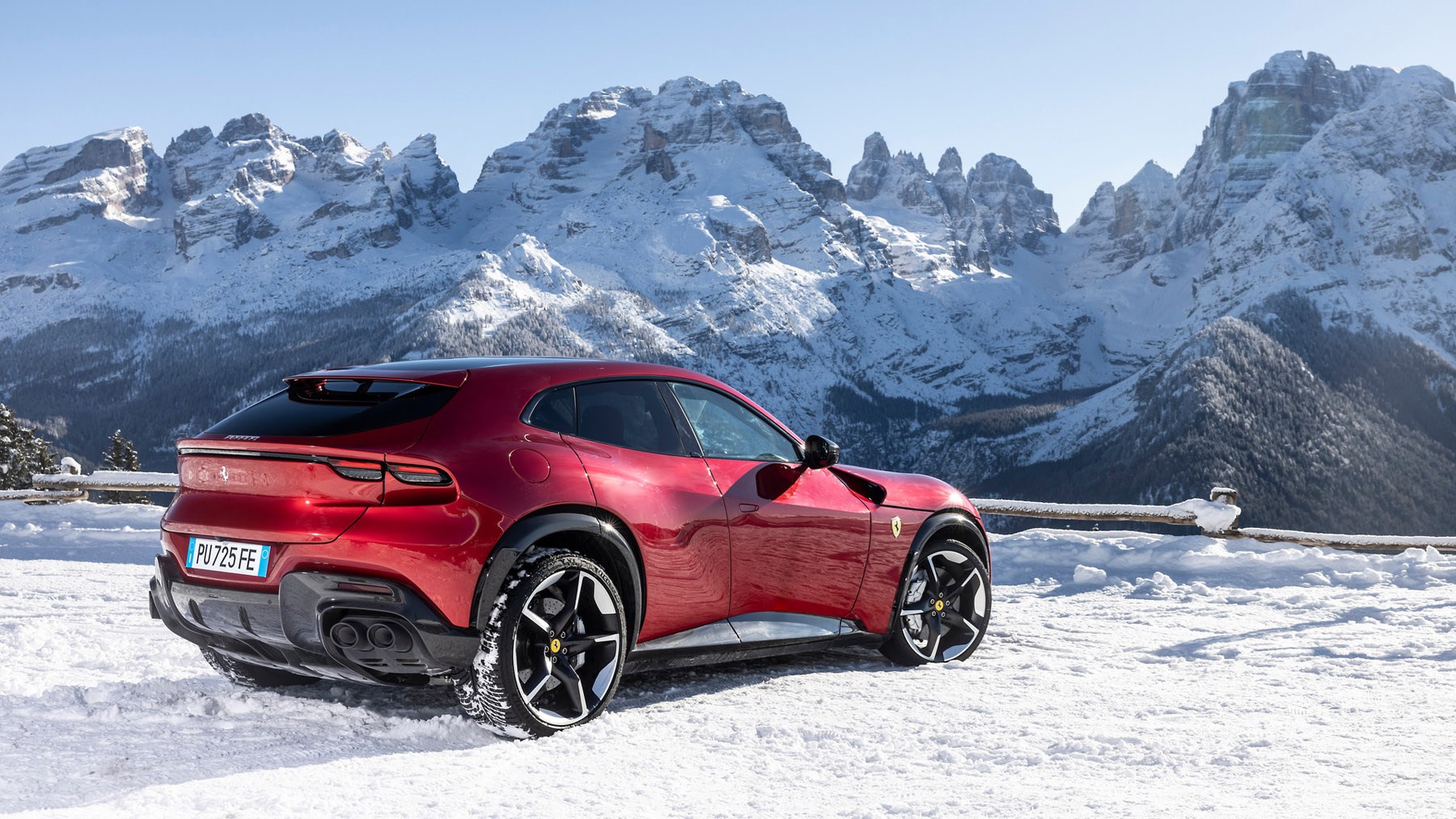► Ferrari’s first ever four-door four-seater
► 715bhp, 528lb ft from 6.5-litre V12
► New 2023 Ferrari Purosangue review
Behold: the Ferrari Purosangue. It’s got a 6.5-litre V12, a 49/51 per cent weight distribution and a price tag in excess of £300k. Sounds very Ferrari, right?
Well, in reality, the Purosangue is uncharted territory for Maranello in the same way that the Cayenne was for Porsche, the Urus for Lamborghini and the DBX for Aston Martin. Hold the front page, Ferrari’s made an SUV…
Is it really an SUV?
Depends who you ask. Mention the three letters to Ferrari and you get the feeling they’d really rather you didn’t sully their latest masterpiece with such a common acronym, yet scan the official press release and it’s already been mentioned by paragraph three. It’s clearly a touchy subject, but does anyone care?
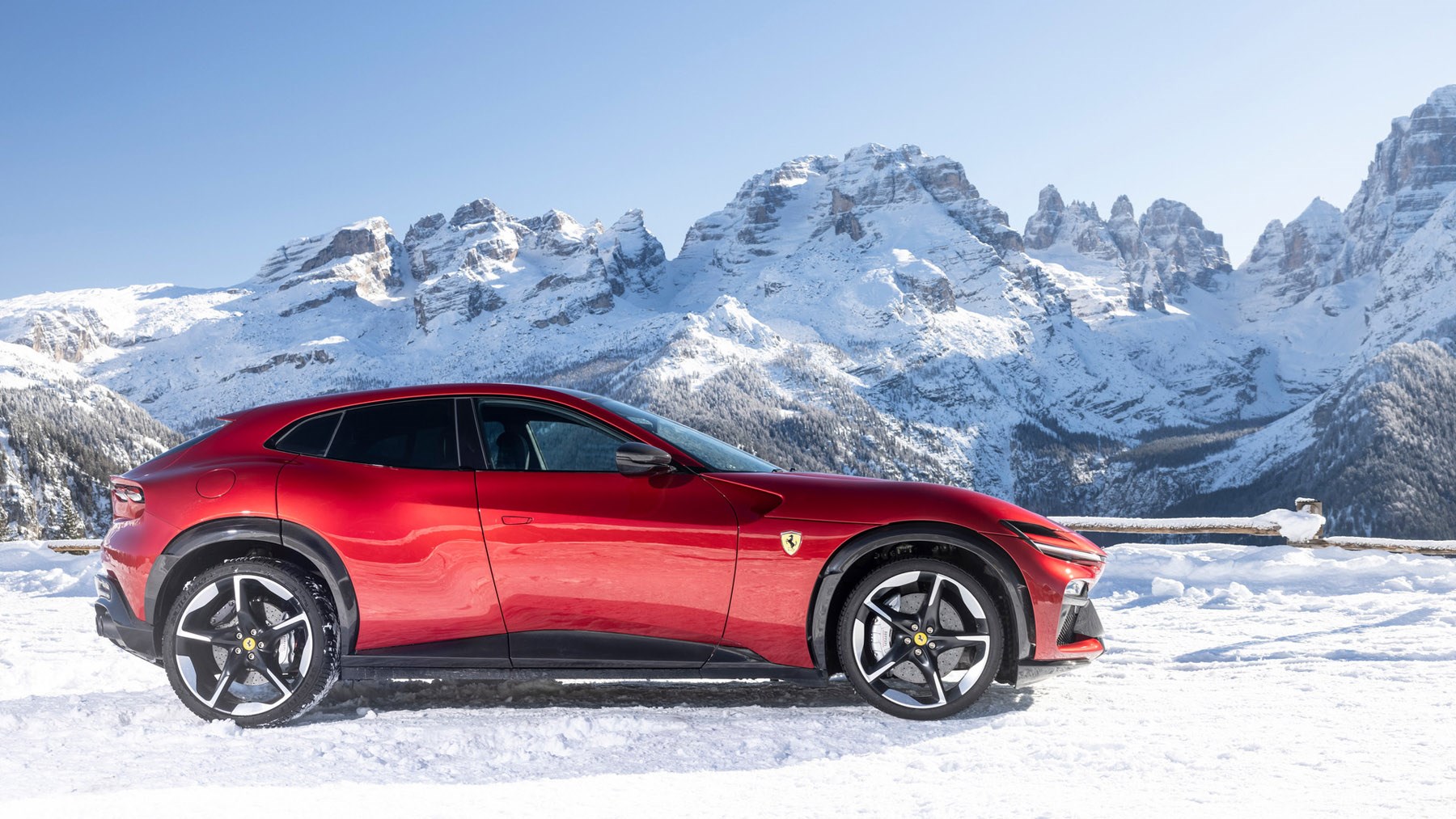
Probably not – especially when it looks as good as this. Ferrari’s somehow managed to take the frumpiness and heft of an SUV out of the Purosangue’s design – this in spite of it being nearly five metres long and two metres wide. It’s full of neat details, too, from the aerobridge just forward of the A-pillar, to the DRLs set between two pairs of air intakes – thus meaning the front end is dominated by blown aero ducts rather than headlights – it’s a swooping and genuinely unique design.
Ferrari Purosangue review: what’s the cabin like?
Ferrari says the cabin is inspired by the SF90 Stradale, but there’s no doubt it feels better suited to the Purosangue than a two-seat hypercar. It’s a bold, clean design that gives each occupant the feeling of their own individual space and tech without losing the cocooned-in feel of a proper sports car.
The material choice throughout is second to none, ranging from beautifully stitched leathers to a carbon fibre weave that integrates fine copper wire. Fear not, though, high-strength fabric used in military uniforms lines the floor of the Purosangue, meaning muddy feet (or paws) needn’t cause any arguments. What’s more, it’s proof that Ferrari has actually thought carefully about the rugged requirements of an SUV – and yet there’s still room for the odd party trick…
Should the front seat occupants want to adjust the climate control, seat heating or even massage function, a cylindrical touch control panel rises out of the dashboard and presents the necessary options. Sure, a button or regular dial would have been easier to use, but there’s no denying that the sense of theatre is palpable and very welcome. Rear seat passengers get the same, minus the massage function capability.
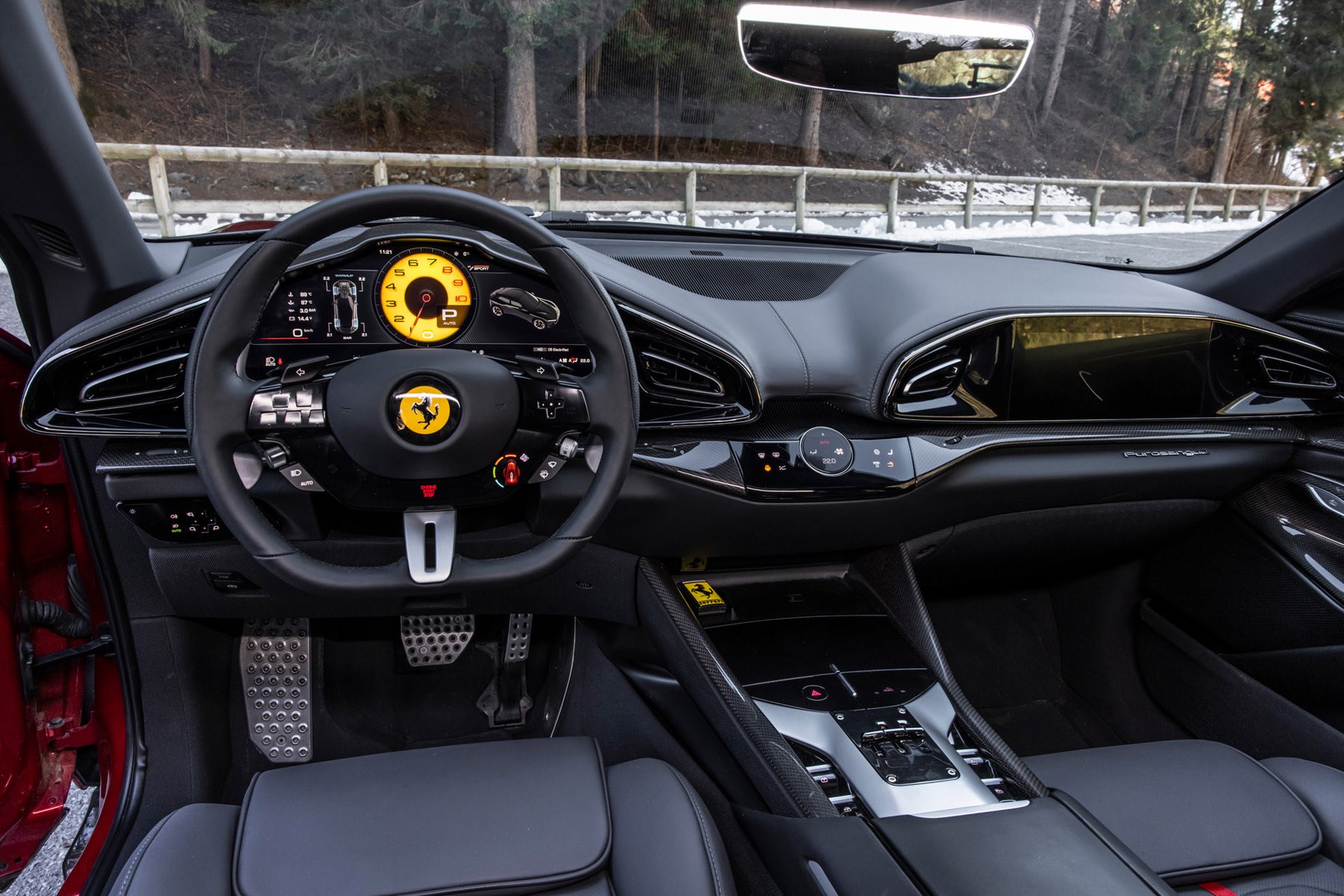
Special mention has to go to the Burmeister 3D Surround Sound System that makes its debut in a Ferrari as standard equipment. Complete with a ribbon tweeter and subwoofer housed in its own closed cabinet, the power and clarity of the audio makes for an able substitute for when the V12 symphony under the bonnet needs a rest.
Has it got a big boot?
Ah, yes, the boot. It seems odd talking about practicality in a V12 Ferrari Purosangue review but here goes. The boot measures up at 473 litres with all seats in place, meaning it’s around the same as a hybrid Range Rover Evoque. The rear seats also slant forwards or fold down entirely to create more room, while there’s a hidden storage area beneath the boot floor.
Sounds impressive but bear in mind that the Lamborghini Urus offers up 616 litres and the Aston Martin DBX 632 litres which, if you’re bringing back fine wines from a trip to the continent, adds up to many gallons of lost Chateau Beychevelle.
Back to that V12 engine…
Yes, quite. Codenamed F140IA, it maintains the same 65-degree angle between cylinder banks and 6.5-litre capacity as the unit in the 812 Superfast, yet there’s considerable modifications to many of the components. For example, the intake, timing and exhaust systems have been completely redesigned, with the end result being more torque at low revs. Ferrari boasts that 80% of maximum twist is available from just 2,100rpm, with the full 528lb ft arriving at 6,250rpm.
It’s hard to make a proper assessment of the torque in everyday driving as the eight-speed DCT box manages the gearchanges so carefully that a flex of the right foot sees an instant kick down and drop into the power band. However, hold it in gear and the firm, linear pull from the V12 oozes luxury with an added peak of excitement.
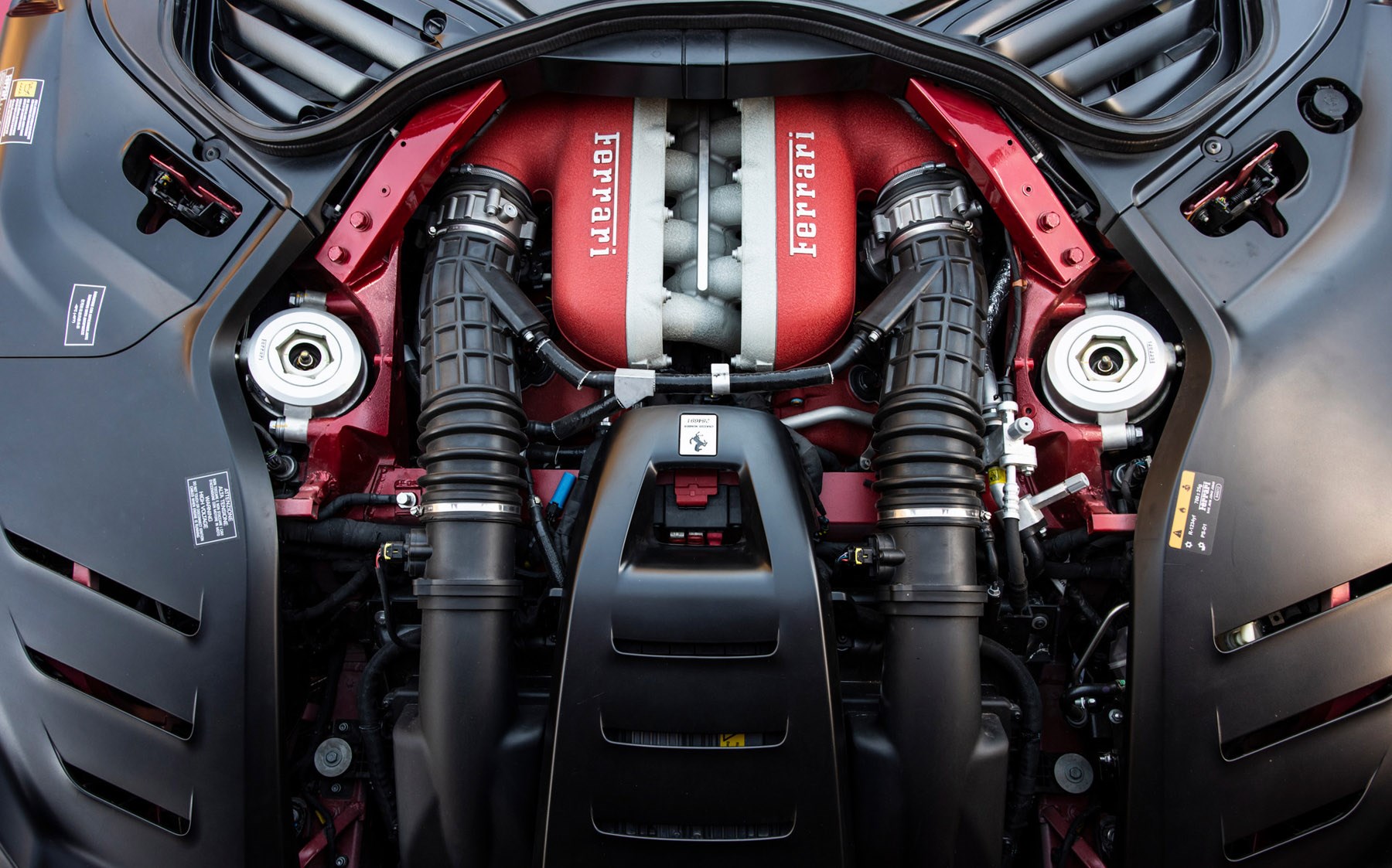
The sound is low and cultured, promising and delivering more as the revs increase. The response from the throttle is crisp and predictable. It’s a fun car to drive sensibly in that you don’t have to be going at 10/10ths to appreciate the appeal of a huge naturally aspirated V12 full to the brim with Ferrari’s latest engineering wizardry. Having said that, when you do go to 10/10ths the experience is spectacular.
Total output is 715bhp at 7,750rpm yet the needle goes beyond 8k before a gearchange is demanded. And while the dry kerb weight is in excess of two tonnes (make that roughly 2.25 tonnes once people and fluids are onboard), 0-62mph arrives in 3.3 seconds, with 120mph coming up in 10.6. However, it’s not the frantic whippet-like run to the red line like you get in the 812. The Purosangue revs slower and has less of a crescendo than its supercar sibling, the extra weight and redesigned torque curve seeing to that.
It doesn’t for a moment feel slow and the gearchanges are lightning fast, but there’s a more considered, in-control manner to the way the Purosangue gains speed under full power. Happily, the soundtrack is anything but pared back. Blasting through the numerous tunnels that lined our test routes in Northern Italy, the baleful howl of the V12 was enough to bring all other traffic to a halt and send tingles down your spine. It may be an SUV, but the soundtrack is one of the best you can buy.
Is it comfortable?
We’ve already mentioned the incredible cabin, but what’s perhaps even more of an achievement is how well the Purosangue rides on 22-inch wheels at the front and 23-inch wheels at the back. Our car was on Michelin Pilot Alpin 5 tyres and the level of comfort, both at high and low speeds, was striking. Always supple, always ironing out small imperfections, the overall feeling was that Ferrari certainly hadn’t thrown comfort out the window in order to get such a big (it’s nearly five metres long) and heavy car to handle like a Ferrari should.

The only slight let-down on the refinement front was the wind noise at Autostrada speeds (around 80mph). It’s not unbearable, but compared to the level of comfort on polish on show from the rest of the car, it certainly feels intrusive.
Is it as fun as a proper Ferrari?
The answer to this question should be a clincher – and Ferrari knows it – so they’ve gone to great lengths to make the Purosangue handle as well as possible given its bulky profile. This includes introducing what Ferrari calls its active suspension technology featuring Multimatic’s True Active Spool Valve (TASV) System.
In essence, the Purosangue does away with traditional anti-roll bars and instead has compact electric motors on each corner that can apply force to the axis of the damper. The result is up to 50% less roll and pitch angles, as well as greater filtering of poor road surfaces from the cabin. It’s stupendously complicated – even by Maranello’s standards – exchanging huge amounts of data with the car’s six-way Chassis Dynamic Sensor nerve centre and needing its own cooling system and 48V power supply.
Incredibly, it can even manipulate the centre of gravity on the car as it travels through a corner, considering the entry and exit phase and their different requirements from the suspension. For example, as the Purosangue drives out of a corner, roll stiffness is shifted rearward in order to give greater stability and driver confidence.
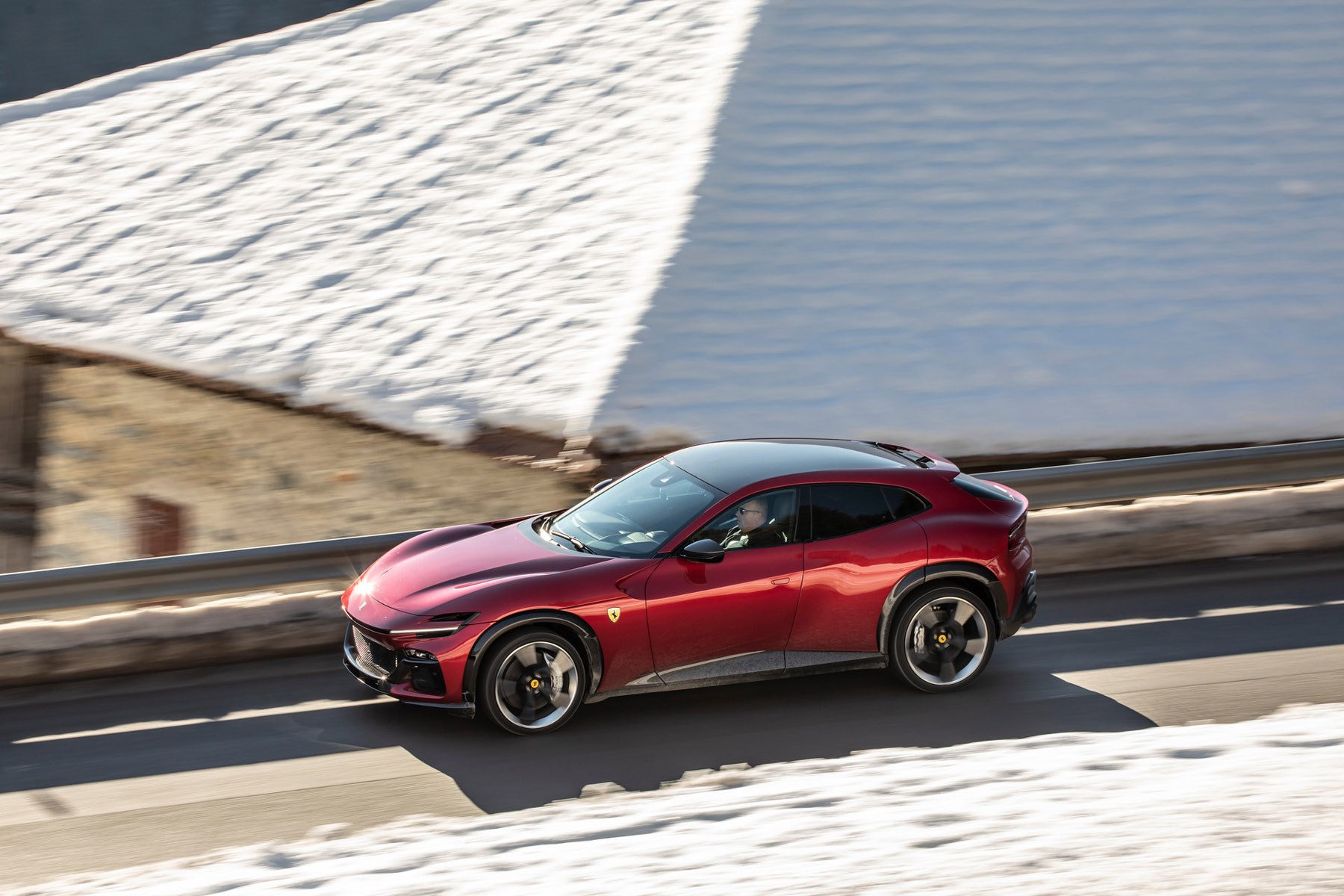
Teamed with features like all-wheel steering (off the 812 Competizione) and Side Slip Control 8.0, the Purosangue has the kind of agility and body control that traditional GT cars would be proud of. Granted, the steering isn’t brimmed with feel (it seldom is on a modern Ferrari), but the ability to put the car where you want, when you want it is mind-blowing. In fact, it’s so impressive that Ferrari’s chief test driver Raffaele de Simone reckons it’s probably the company’s quickest car when driven across your average uneven country road.
On that point, Ferrari’s famous ‘bumpy road mode’ is gone and instead been replaced by a choice of three different damper settings – soft, medium and hard. Very straightforward. The drive modes have also been tweaked, and now consist of Ice, Wet, Comfort, Sport and ESC Off, although depending on the conditions the aforementioned modes will automatically tweak their settings to suit.
Slithering around on a snowy mountain pass with the Alpin 5 winter tyres, the Purosangue was surprisingly approachable even with everything turned off, yet the nannying of the Ice mode will no doubt be a welcome safety blanket for those keen not to risk their £300k Ferrari.
Is it perfect, then?
Not quite. For starters, the infotainment controls are once again located on the steering wheel as touch buttons. It was the same deal in the 296 GTB and we hated them. For the Purosangue, Ferrari claims to have improved the usability by tidying up the menus and added indented buttons – yet it’s still massively frustrating. Try answering an iPhone with wet fingers and you’ll get an impression of what it’s like to operate Apple CarPlay in the Purosangue.
Another annoyance comes in the shape of the rear suicide doors. When outside the vehicle they can be opened automatically, just like in a BMW i7. However, unlike in a BMW i7, there’s no sensors to stop them opening into the nearest bollard and creating a five-figure repair bill.

However, perhaps the biggest faux-pas uncovered by our Ferrari Purosangue review is related to how the car has been marketed. Ferrari claims that it is a four-door, four-seater with zero compromise to the brand or any of its existing sports cars. It’s a huge claim and one that’s simply not true. Sure, it’s dynamically brilliant for an SUV, but that doesn’t mean that it can go toe-to-toe with other front-engined V12 Ferraris – such as the 812 Superfast.
Start throwing it into corners and despite the trick suspension it clearly feels heavier especially under braking and during mid-corner weight transfer. What’s more, the four-wheel drive system is monumentally complicated and the end result is a feeling not as pure as a RWD-only thoroughbred. Such comparisons may seem unfair, but the Purosangue’s billing demands them and it’s perhaps testimony to the engineering that this two-tonne, five-metre long SUV isn’t embarrassed by far lower, lither sports cars.
Verdict
Ferrari rarely misses the mark, but if they were ever going to the Purosangue would be a prime place to do it. Well out of Maranello’s comfort zone, many will still be amazed at its very existence especially after years of denial from Ferrari. However, if the question is whether arguably the world’s most prestigious car maker has managed to successfully transfer its DNA into an SUV then the answer is yes – very much so.
The Purosangue has the looks, sound and pace of a proper Ferrari, while the cabin and outright luxury is second to none. It does have its flaws (what Italian supercar doesn’t) and dynamically it’s not quite a match for Ferrari’s low-slung sports cars, but in the grand scheme these are small complaints. The headline here is that Ferrari has made an SUV that’s fit for the badge.
